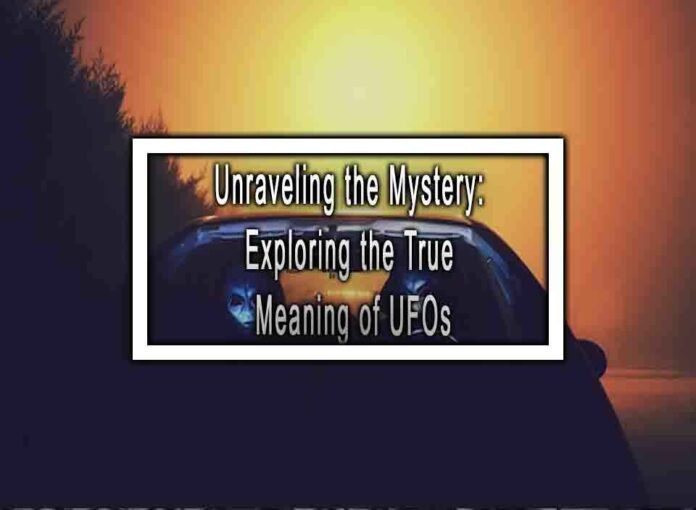Unidentified Flying Objects (UFOs) have captivated the human imagination for decades, sparking debates, speculation, and conspiracy theories. While UFOs are often associated with extraterrestrial life and alien visitations, exploring their true meaning involves considering various perspectives and possibilities. Let’s unravel the mystery and explore some of the key aspects surrounding UFOs:
Definition of UFOs:
- A UFO, by definition, is any flying object that cannot be identified by the observer at a given time and place. It is crucial to emphasize that “unidentified” does not necessarily mean “extraterrestrial.”

- A UFO, by definition, is any flying object that cannot be identified by the observer at a given time and place. It is crucial to emphasize that “unidentified” does not necessarily mean “extraterrestrial.”
Historical Context:
- UFO sightings have been documented throughout history, with reports dating back centuries. However, the modern fascination with UFOs emerged during the mid-20th century, coinciding with the dawn of the space age.
Natural and Man-Made Phenomena:
- Many UFO sightings can be attributed to natural phenomena like meteorological events, atmospheric anomalies, or celestial bodies. Additionally, man-made objects such as experimental aircraft, drones, and satellites can also account for some sightings.
Extraterrestrial Hypothesis:
- The most popular and enduring theory suggests that some UFOs could be evidence of intelligent extraterrestrial life visiting Earth. Proponents argue that certain sightings defy conventional explanations and may indicate advanced technology beyond our current understanding.
Government Involvement:
- Government agencies, such as the United States’ Pentagon, have declassified and released previously classified information about UFO sightings. These disclosures have fueled speculation about official knowledge of unexplained phenomena.
Scientific Skepticism:
- The scientific community typically approaches UFO claims with skepticism, demanding robust evidence before accepting any extraordinary explanations. The lack of concrete proof has led many scientists to remain cautious about ascribing UFOs to extraterrestrial origins.
Psychological and Sociological Factors:
- Some UFO sightings can be attributed to psychological and sociological factors. These may include misperceptions, optical illusions, mass hysteria, and cultural influences that shape people’s expectations and interpretations of unusual events.
Government Secrecy and Conspiracy Theories:
- The secrecy surrounding government research and military projects has contributed to conspiracy theories suggesting that governments are concealing evidence of extraterrestrial contact. While some government secrecy is legitimate for national security reasons, it also feeds into speculation.
Ongoing Investigations:
- Organizations like the Mutual UFO Network (MUFON) and the Center for the Study of Extraterrestrial Intelligence (CSETI) continue to investigate UFO sightings and experiences, collecting data and testimonies to further our understanding.
The Search for Evidence:
- Scientific efforts, such as the search for microbial life on Mars and the study of exoplanets, are ongoing. Discoveries in astrobiology and advancements in technology may provide insights into the potential existence of extraterrestrial life.
In conclusion, unraveling the mystery of UFOs involves a multidisciplinary approach that considers natural phenomena, human psychology, scientific scrutiny, and the possibility of extraterrestrial life. While UFOs remain enigmatic, ongoing research and open dialogue are essential to advancing our understanding of these intriguing phenomena, and they should be approached with critical thinking and skepticism until concrete evidence emerges to support any particular theory.











